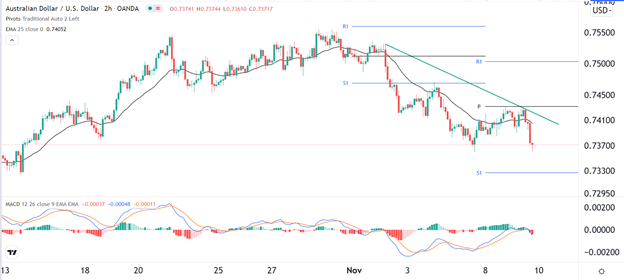Bearish View
Sell the AUD/USD and set a take-profit at 0.7300.
Add a stop-loss at 0.7450.
Timeline: 1-2 days.
Bullish View
Set a buy-stop at 0.7400 and a take-profit at 0.7500.
Add a stop-loss at 0.7300.
The AUD/USD pair declined to the lowest level since October 13 ahead of the latest US inflation numbers. The pair dropped to 0.7360, which is about 1% below the highest level this week.
US Inflation and Australian Jobs Data Ahead
The AUD/USD has erased some of the gains made on Monday as investors waited for the US inflation numbers. The data will be important since it will come a few days after the country published October’s employment numbers. They are also important since they could show that the country’s inflation surged to the highest level in more than 30 years.
Meanwhile, the data will come exactly a month after the Federal Reserve delivered its interest rate decision. In it, the bank decided to start tapering its asset purchases by about $15 billion. It will continue reducing the purchases by $15 billion every month. Its hope is that it will conclude its quantitative easing policy by mid next year.
At the same time, the bank hinted that it could accelerate or slow the asset purchases depending on the state of the economy. Therefore, if inflation numbers are better than expected, it could push the Fed to accelerate its purchases.
The AUD/USD also fell as investors waited for upcoming Australia’s jobs numbers that will be published on Thursday morning. Data compiled by Reuters show that analysts expect that the country’s unemployment rate rose from 4.6% to 4.8% while the economy added more than 50,000 in October.
The Australian economy has recovered relatively well helped by the rising rising commodity prices. The prices of most commodities have risen sharply as investors wait for more demand. This is partly because of the latest infrastructure package. Indeed, Australia will benefit directly since it has major mineral deposits that are used in battery manufacturing.
AUD/USD Forecast
The AUD/USD pair has been in a strong bearish trend lately. It has dropped by more than 2.50% this month and is trading at the lowest level since November. The pair has also moved below the descending green trendline. Most importantly, it has moved below the standard pivot point and the 25-period moving average.
Therefore, the pair will likely keep falling ahead of the US inflation data. The next key support level to watch is 0.7300, which is slightly below the first support of the pivot point.

